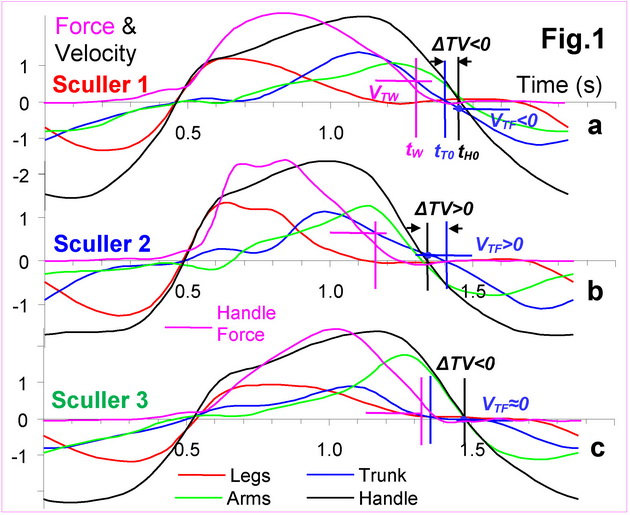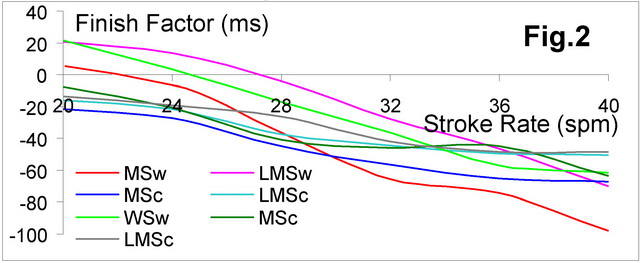Criteria of the technique at the finish

The main goal of the rowing stroke’s
finish is the effective change of direction of movement of the rower’s CM,
which is located in the upper trunk at this phase. Biomechanical analysis (RBN
2006/09) revealed that all arguments are in favour of using the arms to pull
through the handle to return the trunk. Therefore, velocities of the handle,
trunk and arms should be analysed in conjunction with the handle force.
Fig.1 shows force at the
handle as well as it’s velocity, along with the velocity of the body segments
of three scullers at 32spm, which have very different finish techniques. Using
the logic similar to catch analysis, the following criteria could be suggested
for evaluation of the trunk and handle coordination at finish:
1.
Delta time ΔTV (ms) between moments of changing direction at the trunk tT0
and the handle tH0 (ΔTV = tT0 – tH0),
which could be graphically represented by a distance on the X-time axis between
points where curves of the trunk and handle velocities cross the axis in the
positive-to-negative direction (Fig.1). As this definition is similar to the
Catch Factor, we would call this criterion Finish Factor FF. Negative FF
means trunk changes direction earlier than the handle (target), positive FF – later (incorrect).
2.
Trunk velocity at finish VTF (m/s) - at the moment
when the oar changes direction from drive to recovery. Negative VTF
means trunk changes direction earlier than the handle (FF must be also negative,
the target technique) and already moves to the stern at finish. Positive VTF
means the trunk still moves to the bow, when the handle changes direction at
finish (incorrect technique).
Moreover, it is important not
only to return the trunk through the handle at finish, but also to use it
actively for maintaining force during the final part of the drive. The
following criteria may help to indicate this :
3.
Delta time ΔTF (ms) between the moments when handle force drops below the
“Wash” value (RBN 2017/03) tW and changing direction
at the trunk tT0: ΔTF= tT0 - tW .
4. Trunk velocity at the moment of “Wash” time VTW (m/s), when handle force drops below the threshold.

Sculler 1 (Fig.1) has significant trunk velocity VTW
= 0.84m/s at “Wash” time that means his trunk actively works to produce force
at finish. Then, he spends ΔTF=147ms till his trunk stops, but his
handle continues to move to the bow a short time, so his Finish Factor FF
was negative (-47ms) and the trunk already moves to the stern at the finish
with a noticeable velocity VTF -0.20 m/s. Obviously,
Sculler 1 performs “finish through the handle”.
Sculler 2 has the same trunk velocity VTW at “Wash”
time, but he spends more than twice the time ΔTF=297ms until his trunk
stops. His handle stops earlier than the trunk, so his Finish Factor FF
was positive +63ms. The trunk has positive velocity VTF = +0.15m/s
at the finish and continues moving to the bow, while the handle is already
moving to the stern. It is clear that Sculler 2 uses the ineffective “finish
through the stretcher” technique and just wastes time and energy for idle trunk
movement.
Sculler 3 has much lower trunk velocity VTW = 0.14m/s
at “Wash” time that means his trunk doesn’t really work at finish and he uses a
faster arms velocity to maintain handle force. Then, his trunk stops quite
early (ΔTF=102ms) with the handle still going towards the bow. His Finish
Factor FF was negative at -74ms, but the trunk remains nearly
stationary and its velocity at finish VTF is only -0.01m/s. This
technique could be called “a passive trunk at finish” and appeared to be not
very productive in terms in using the rower’s mass and big muscles at finish.
To establish benchmarks for the above criteria, the BioRow database was analysed (n=7500). Only data in small boats (1x, 2x and 2-) was used, where measurements of trunk movement is a part of standard testing routine. The average value of the Finish Factor was -38.9±53.8 ms (mean±SD) for the whole data, so it had very high variation (it ranges from -200 to +150ms) in various finish techniques. FF became more negative at higher stroke rates (on average, from -14ms at 20spm down to -59ms at 40spm, Fig.2), but due to its very high variation, the correlation factor r=-0.30 was not significant.

In sweep categories, the average
FF
was positive at low rates (which is quite a common mistake), but at high rates
it became more negative than in scullers. At racing rates 36-40spm, FF
was quite similar at about -50 to -60ms in all categories, except open male
rowers, where it was more negative at -80ms. Athletes of the open category had a
more negative average FF than lightweights, because they
need more time to change the direction of heavier trunk mass.
On average, the World best rowers always had a consistently negative
Finish Factor, which is an important part of their efficient technique. More analysis of finish
technique to be done…
©2017 Dr. Valery Kleshnev www.biorow.com



